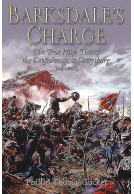Barksdale's Charge (Paperback)
The True High Tide of the Confederacy at Gettysburg, July 2, 1863
By
Phillip Thomas Tucker
Imprint: Casemate Publishers
Pages: 336
Illustrations: 16pp of photos
ISBN: 9781612002279
Published: 16th January 2017
Imprint: Casemate Publishers
Pages: 336
Illustrations: 16pp of photos
ISBN: 9781612002279
Published: 16th January 2017
You'll be £14.99 closer to your next £10.00 credit when you purchase Barksdale's Charge. What's this?
+£4.99 UK Delivery or free UK delivery if order is over £40
(click here for international delivery rates)
Order within the next 8 hours, 36 minutes to get your order processed the next working day!
Need a currency converter? Check XE.com for live rates
(click here for international delivery rates)
Order within the next 8 hours, 36 minutes to get your order processed the next working day!
Need a currency converter? Check XE.com for live rates
On the third day of Gettysburg, Robert E. Lee launched a magnificent attack. For pure pageantry it was unsurpassed, and it also marked the centerpiece of the war, both time-wise and in terms of how the conflict had turned a corner—from persistent Confederate hopes to impending Rebel despair. But Pickett’s Charge was crushed by the Union defenders that day, having never had a chance in the first place.The Confederacy’s real “high tide” at Gettysburg had come the afternoon before, during the swirling conflagration when Longstreet’s corps first entered the battle, when the Federals just barely held on. The foremost Rebel spearhead on that second day of the battle was Barksdale’s Mississippi brigade, which launched what one (Union) observer called the "grandest charge that was ever seen by mortal man.”Barksdale’s brigade was already renowned in the Army of Northern Virginia for its stand-alone fights at Fredericksburg. On the second day of Gettysburg it was just champing at the bit to go in. The Federal left was not as vulnerable as Lee had envisioned, but had cooperated with Rebel wishes by extending its Third Corps into a salient. Hood’s crack division was launched first, seizing Devil’s Den, climbing Little Round Top, and hammering in the wheatfield.Then Longstreet began to launch McLaws’ division, and finally gave Barksdale the go-ahead. The Mississippians, with their white-haired commander on horseback at their head, utterly crushed the peach orchard salient and continued marauding up to Cemetery Ridge. Hancock, Meade, and other Union generals desperately struggled to find units to stem the Rebel tide. One of Barksdale’s regiments, the 21st Mississippi, veered off from the brigade in the chaos, rampaging across the field, overrunning Union battery after battery. Barksdale himself was killed at the apex of his advance. Darkness, as well as Confederate exhaustion, finally ended the day’s fight as the shaken, depleted Federal units on their heights took stock. They had barely held on against the full ferocity of the Rebels, on a day that decided the fate of the nation. Barksdale’s Charge describes the exact moment when the Confederacy reached its zenith, and the soldiers of the Northern states just barely succeeded in retaining their perfect Union.
There are no reviews for this book. Register or Login now and you can be the first to post a review!
About Phillip Thomas Tucker
Phillip Thomas Tucker, chief historian of the 81st Training Wing, Keesler Air Force Base in Biloxi, Mississippi, is the author/editor of several Civil War titles, including The 1862 Plot to Kidnap Jefferson Davis.
More titles by Phillip Thomas Tucker
Other titles in Casemate Publishers...
















